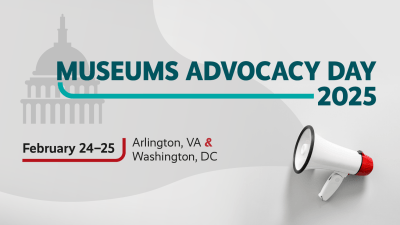
We’re halfway through the serial publication of CFM’s set of scenarios for museum planning! Bright and dark versions of the year 2040, crowdsourced from the hopes and fears of AAMers, are available now, and our third scenario will be released next week. You can access all the content on the landing page for TrendsWatch 2018. As I work on these scenarios, I’ve been revisiting earlier CFM explorations of the Cone of Plausibility. Today’s post, adapted from an essay I wrote five years ago, explores how one particular “four futures” framework might look like when applied to museums. I think it’s held up pretty well, especially in pointing to the Santa Cruz MAH as an example of a museum successfully embodying a metaphorical approach to creating a better future. Most recently, the MAH has expanded its role as public agora from the local to the global community with the launch of the initiative Of By For All.
–Elizabeth Merritt, VP Strategic Foresight and Founding Director, Center for the Future of Museums
In 2013, Nicholas Negroponte, co-founder of MIT Media Lab and founder of the One Laptop Per Child project, keynoted at the WorldFuture conference. In the ten minute extract of his talk embedded below, he offers four ways of looking at potential futures: Extrapolative, Orthogonal, Metaphorical, and Contrarian, and offers examples of each. I think his framework is a useful lens for thinking about what futures fall within the Cone of Plausibility, and it spurred me to try to come up with museum examples for each category.
Extrapolative futures are ones we tend to assume will happen, because our default habit of thought is that the future will be more or less like today (only more so). He lists as examples industries that assumed they would remain as based on non-digital formats for photography, music, movies, books. The danger, of course, is that if we bet wrong (like Kodak doubling down on film-based pictures) someone else (like Instagram) is going to eat our lunch.
For museums, I’m thinking the equivalent might be:
Traditional static, expertise-based exhibits. Some people are very resistant to a future in which museums are characterized by participatory, experienced-based formats . See, for example, the recent snarking about the Santa Cruz MAH under Nina Simon’s leadership. These critics conveniently overlook the fact that before its recent revitalization, the “traditional” museum was going broke. Which is a pretty good indication that in that local market, at least, the old business model was moribund.
Orthogonal futures come at us from the side—they may be in our peripheral vision, but we underestimate the probability that they will move to front and center. As examples, Negroponte points to the rise of wireless communications, “non-ownership” (aka the sharing economy), Kickstarter (crowdfunding more generally) and Tinder (one of the first “swiping” apps for assessing potential dates).
For museums, try:
Hard-nosed capitalist business models. Some museums already rely on income from associated for-profit business ventures, and some nonprofits are dabbling in hybrid legal structures like benefit corporations, but what if the current financial & political climate makes this alt funding strategy take off? In the future, the average museum could be a certified B-corp that attracts investors as well as donations.
Metaphorical futures come about when people’s thinking is so shaped by a figure of speech, that the language in fact creates a new reality. Negroponte cites the way physical “desktops” shaped our computer operating environments.
For this one, I like the metaphor of Museum as Agora. We’ve heard for decades about the desire for museum to be a “place for dialog.” What if we actually managed to create a future in which museums were widely seen as the “center of athletic, artistic, spiritual and political life” of their cities? What would that look like? (Notice all those links track back to Santa Cruz MAH. Hmm.)
Finally Negroponte comes to Contrarian futures—futures that are built in the face of popular opposition. Negroponte lists, for examples, nuclear power and genetically modified organisms (GMOs) as technologies he thinks are necessary and inevitable for successful human futures, however much some people may feel they are evil and dangerous. (Then he segues to a rant about iPhones and the Internet of Things that I don’t think belongs in this section, but you can bleep over that.) He lists education in his slide, but never gets to the commentary—I wish he had, because I wonder if he was going to mention MOOCs & internet based education more generally, which some people are already slamming as either overblown, under-performing or both, while others hail it as the future of egalitarian, affordable learning. This is an absolute invitation to tick people off (otherwise it won’t be contrarian, right?) So I propose:
The Digital Museum—where the majority of the benefit provided to society by museums is in the form of their digital assets—freely and widely shared as raw material including data, images, 3-D scans as well as “value-added” content such as online courses and virtual exhibits. (For a recent example, see the new Kremer Museum, an entirely virtual museum displaying digital reproductions of a private collection of art from the Dutch golden age.) Would physical museums cease to exist in this scenario? No more than windmills would be banished in Negroponte’s nuclear-fueled future—they just would be a minor player in the overall cultural scene.
Your turn. Feel free to build on or challenge my examples, or come up with your own, using the comments section below.
Skip over related stories to continue reading article








Comments